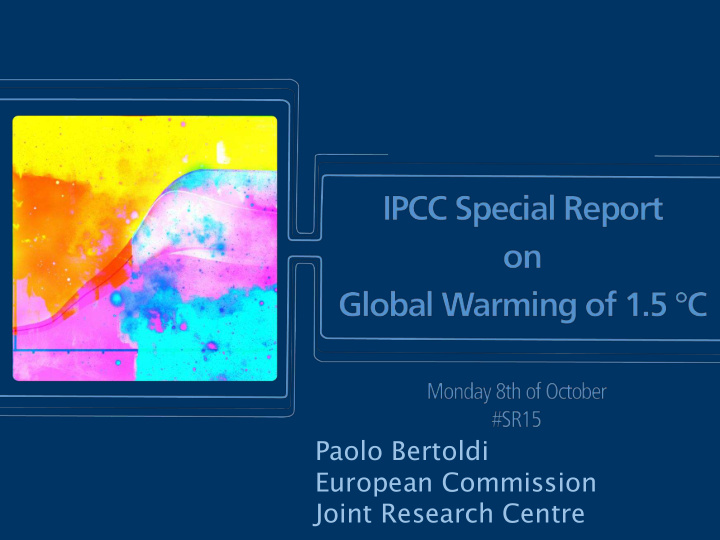



Paolo Bertoldi European Commission Joint Research Centre
Global Warming of 1.5°C An IPCC special report on the impacts of global warming of 1.5°C above pre- industrial levels and related global greenhouse gas emission pathways, in the context of strengthening the global response to the threat of climate change, sustainable development, and efforts to eradicate poverty. 1
2
The report in numbers 91 Authors from 40 Countries 133 Contributing authors 6000 Studies 1 113 Reviewers 42 001 Comments 3
Understanding Global Warming of 1.5°C 4
Where are we now? Since preindustrial times, human activities have caused approximately 1.0°C of global warming. Already seeing consequences for people, • nature and livelihoods At current rate, would reach 1.5°C between • 2030 and 2052 Past emissions alone do not commit the • world to 1.5°C 5
Where are we now? 5
Projected Climate Change, Potential Impacts and Associated Risks 2
Impacts of global warming 1.5°C At 1.5°C compared to 2°C: Less extreme weather where people live, • including extreme heat and rainfall By 2100, global mean sea level rise will be • around 10 cm lower 10 million fewer people exposed to risk of • rising seas 6
Impacts of global warming 1.5°C At 1.5°C compared to 2°C: Lower risk to fisheries & the livelihoods that • depend on them Lower impact on biodiversity and species • Smaller reductions in yields of maize, rice, • wheat Up to several hundred million fewer people • exposed to climate-related risk and susceptible to poverty by 2050 Global population exposed to water • shortages up to 50% less 6
Emission Pathways and System Transitions Consistent with 1.5°C Global Warming 2
Greenhouse gas emissions pathways To limit warming to 1.5°C, CO 2 emissions • fall by about 45% by 2030 (from 2010 levels) o Compared to 20% for 2°C To limit warming to 1.5°C, CO 2 emissions • would need to reach ‘net zero’ around 2050 o Compared to around 2075 for 2°C Reducing non-CO 2 emissions would have • direct and immediate health benefits 1
Greenhouse gas emissions pathways 1
Greenhouse gas emissions pathways National pledges are not enough to limit • warming to 1.5°C Avoiding warming of more than 1.5°C • would require carbon dioxide emissions to decline substantially before 2030 We would need to start taking carbon • dioxide out of the atmosphere Implications for food security, ecosystems • and biodiversity 1
Greenhouse gas emissions pathways 1
Greenhouse gas emissions pathways Limiting warming to 1.5°C would require • changes on an unprecedented scale o Deep emissions cuts in all sectors (energy, transport, buildings, industry, cities, land) o A range of technologies o Behavioural changes (energy, consumption, food) o Increase investment in low carbon options Progress in renewables would need to • mirrored in other sectors 1
Strengthening the Global Response in the Context of Sustainable Development and Efforts to Eradicate Poverty 2
Climate change and people Close links to United Nations Sustainable • Development Goals (SDGs) Mix of measures to adapt to climate change • and reduce emissions can have benefits for SDGs National and sub-national authorities, civil • society, the private sector, indigenous peoples and local communities can support ambitious action International cooperation is a critical part of • limiting warming to 1.5°C 1
Climate change and people The avoided climate change impacts on • sustainable development, eradication of poverty and reducing inequalities would be greater at 1.5°C rather than 2°C, and if mitigation and adaptation synergies are maximized while trade- offs are minimized Strengthened multi-level governance, • institutional capacity, policy instruments, technological innovation and transfer and mobilization of finance, and changes in human behaviour and lifestyles are enabling conditions that enhance the feasibility of mitigation and adaptation options for 1.5°C consistent systems transitions 1
Conclusions Limiting global warming to 1.5ºC is feasible • and would require rapid, far reaching and unprecedented changes in all aspects of society. 1
Q&A Paolo.bertoldi@ec.europa.eu
Recommend
More recommend